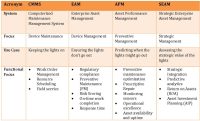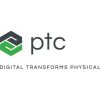Historically, Enterprise Asset Management (EAM) systems evolved to help solve the transactional challenges associated with equipment provisioning, maintenance, resource scheduling and regulatory compliance. The earliest systems (termed CMMS or “Computerized Maintenance Management Systems”) specifically targeted the tasks associated with equipment repair and maintenance, namely managing and tracking work orders, scheduling repair technicians and documenting any field services that were performed.
Soon after, CMMS systems evolved to include an additional range of functions, becoming “Enterprise Asset Management” (EAM) systems. In addition to fulfilling all the existing CMMS functions, EAMs began ensuring organizations met regulatory compliance standards and focused on preventing problems rather than just servicing assets when they needed repair. “Preventive Maintenance” (PM) and “Risk Scoring” became commonplace, and terms such as “on-time work completion” and technician “response time” entered the lexicon of asset management.
Yet even with these advancements, EAM systems have remained primarily transactional in nature—logging tasks, events and resources associated with equipment maintenance and minimizing system outages.
Enter APMs – Enhancing Functionality by Leveraging Data and Technology
As technology continued to advance, Asset Management systems began to find new ways to incorporate technological advances to enhance asset management. Organizations started focusing not only on asset repair and preventive maintenance, but now sought ways to predict potential failures. Preventive maintenance evolved to encompass “prescriptive repair,” incorporating monitoring sensors (often taking the form of connected “smart” sensors) that continually monitor system parameters, and Asset Performance Management (APM) systems were born.
With APMs, organizations began focusing on operational excellence—trying to obtain the most value and use out of every asset. APM systems focused on gaining insights into equipment performance. Their enhanced design sought to maximize asset availability and update. APMs represented a dramatic leap forward for asset management, yet still maintained primarily an asset-centric focus.
Data Integration – the “Next Generation” of Asset Management Systems
Even with the advancements available with APMs, there were still questions that APMs couldn’t answer—and these were typically being asked by executives who were focusing on asset value and ROI:
- Do we have the “right” assets?
- Are we receiving sufficient value from our asset purchases?
- How can we leverage EAM data to improve our bottom line?
These were different kinds of questions—strategic questions—and APMs, even with their advancements, could not answer them. That is because these solutions required integration with other systems and external data sources, crossing the boundaries between asset management, finance, utilization, purchasing, inventory, contracting, clinical outcomes and performance.
The Enterprise Data Warehouse (EDW) “Solution”
Historically, when faced with the need to solve strategic questions (and their requirement for data integration), asset management vendors would respond by recommending organizations pursue an independent custom reporting and integration solution (typically leveraging an Enterprise Data Warehouse [EDW] along with an analytics toolset and reporting platform).
Unfortunately, developing an EDW and integrating multiple disparate systems often becomes a herculean task—and a very expensive one. Most organizations simply do not have the funding, resources and expertise necessary to create an effective EDW, and those that have tried often abandon the effort when costs balloon and the promise of an integrated informatics solution never effectively materializes.
The Strategic Enterprise Asset Management (SEAM) Solution
Organizations are now looking toward EAM and APM vendors to help solve the problems of asset data integration with other systems, and consequently the Strategic Enterprise Asset Management (SEAM) concept was born. SEAM-enabled systems represent a different way of envisioning strategic asset management. Instead of relying on external systems such as Data Warehouses to accomplish integration, SEAM systems marry external data with enterprise asset data, offering native analytics that help answer the strategic questions that will help advance asset management systems and facilitate enterprise asset planning, providing a comprehensive view of asset ROI across the enterprise.

Yet challenges remain, as data integration is not easy. A SEAM implementation will necessitate equilibration of data definitions and data structures across disparate systems, paired with robust and very mature organizational data governance procedures. For example, EAM systems might use different location naming conventions for different operational areas—clinical engineering locations may differ from those of facilities, and Real-Time Location Systems (RTLS) locations may represent yet a third standard. Similarly, manufacturer names, models and devices may differ between EAM and Enterprise Resource Planning (ERP) systems. To be truly effective, a single standard would need to be adopted across all enterprise systems, facilitating not only data integration but also helping to foster and leverage a singular corporate lexicon across business units.
Key Considerations for Organizations
To help organizations determine whether a SEAM system might be right for their enterprise, we’ve compiled some typical questions that you may have asked yourself (or may have heard from corporate executives):
- For equipment we rent or lease, should we renew our contract or purchase these assets outright? How can we compare equipment utilization to ROI to help make this decision?
- I have multiple similar devices from various manufacturers across all our facilities. Does it make sense to replace all these devices with a single device model from a single manufacturer, and if so, which manufacturer and device?
- We received a request to purchase a second robotic surgery device, but our first device required frequent repairs. Can I determine if the estimated uptime would allow for sufficient utilization of this second device to provide a positive return on our organization’s investment?
- We have multiple similar devices from different manufacturers in use. Can I determine which devices are preferred based on their utilization, and can I prioritize the selection of devices with the highest utilization and the lowest total lifetime repair cost?
- When an FDA security alert or equipment recall is issued, can I quickly identify and locate any potentially affected assets and/or subcomponents and implement any required corrective actions?
- Can I determine the total cost of ownership (TCO) by manufacturer and model across all my facilities, and does the TCO vary by location (and if so, why)?
- What is the age distribution of all my assets by department? Does it make sense to replace any device models early due to their high repair costs, even if they’ve not yet reached end-of-life? What is that “break-even” point?
- Which manufacturers offer the greatest discount from list price? Can I forecast if these discounted devices would have higher lifetime repair costs and become more expensive over time (despite the initial discount)? Would it be better for us to invest in a more expensive, but more reliable device from a different manufacturer? At what discount would any higher repair costs still result in a lower overall TCO?
- We have a service contract for devices from a certain manufacturer, that includes free parts replacement. Is this a good strategy for us, or would it be less expensive to service these devices ourselves, and pay ad hoc for any needed parts?
- We have some shared ownership and leased assets where our contracts have specified split maintenance and support costs. Can I track and allocate repair costs based on who is contractually responsible for the maintenance component of each asset?
As we’ve experienced already with Electronic Medical Records (EMRs), data integration and interoperability represent the next frontier in information management. SEAM systems facilitate and focus on information integration, leveraging available data from disparate systems to seamlessly integrate data to solve our most challenging strategic questions. Asset management will evolve to become true Asset Investment Planning (AIP), with organizations assessing individual Return on Assets (ROA) rather than a less granular Return on Investment (ROI) strategy. Our historical reliance on best of breed systems (with admittedly robust but narrow functionality) will need to evolve as we embrace the strategic benefits that SEAM systems have to offer to help organizations realize the “next generation” of Asset Management Systems.







